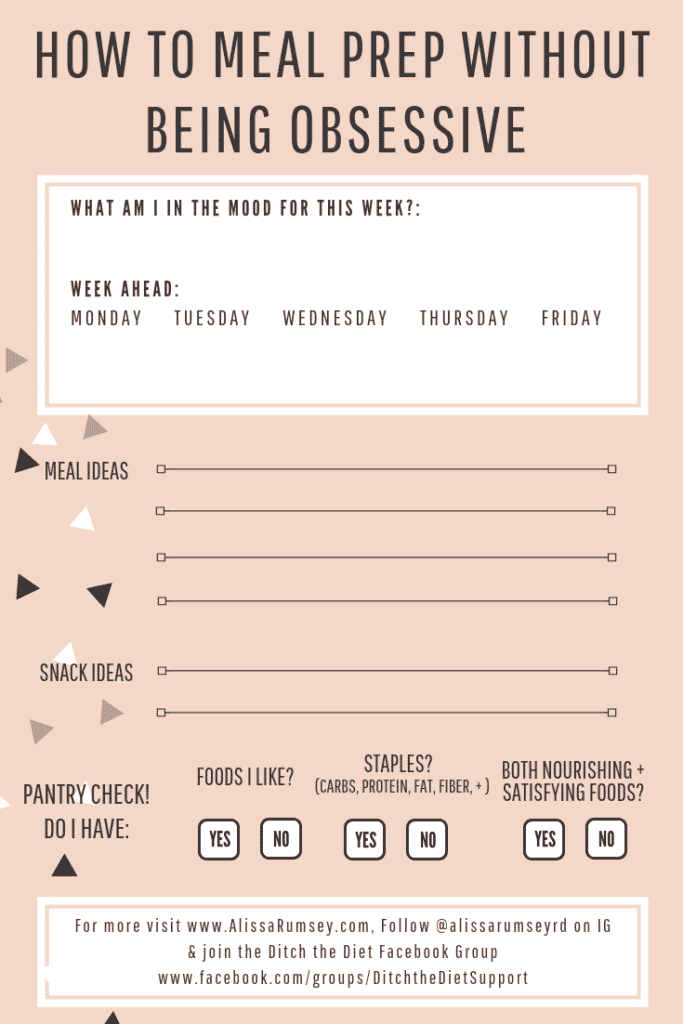Meal Planning with Intuitive Eating: A How-To Guide

Meal prep food photos and “inspiration” can be found all over the internet, but so often these posts promote rigid, restrictive ways of eating that are reminiscent of dieting. Moving away from dieting and towards intuitive eating doesn’t mean that there can’t be any structure around meals and eating – but there’s a way to do it that promotes more flexibility while still listening to your body. Here are tips from some of my favorite non-diet registered dietitians on meal planning with intuitive eating.

Intuitive eating teaches you how to tune back into your internal body cues, like hunger, fullness and satisfaction and ask yourself “what sounds good?” instead of following external factors like diets, meal plans or food rules. But after years of dieting and being exposed to mixed messages about health and nutrition, it can be hard to know what your body really wants. Which is why one of the first questions I suggest people to start asking themselves as they explore intuitive eating is, “What sounds good to me right now?” Learning how to listen to your body in the moment, and figure out what it wants and needs to eat, is an important step in transforming your relationship with food. Which is why the idea of meal planning – or outlining and preparing food ahead of time – can seem counterintuitive. Especially if your idea of a meal plan is rigid, structured, and often comes from a place of restriction or dieting.
In the journey towards becoming (and being) an intuitive eater, meal planning can actually be really helpful. The key is doing it in a way that allows for flexibility, takes your satisfaction and food preferences into consideration, and doesn’t include diet or food rules. Here are suggestions for 12 of my non-diet dietitian colleagues. And don’t miss the intuitive eating meal prep worksheet at the end of the post!
Heather Caplan RDN, registered dietitian and host of the RD Real Talk podcast
Flexibility is a big part of learning to eat intuitively, and practically. I try to have foods on hand that I like, that are satisfying and filling, and that can be versatile for both meals and snacks (e.g. yogurt can be part of my breakfast, or an afternoon snack). I don’t assume I can or will have the exact food that sounds perfect to me in any given moment. I shop for a lot of food staples—fruits, seasonal vegetables, bread, cereals, trail mix, pasta or rice, a sauce or two for stir-fries or pasta dishes, salad greens, and maybe some fish or other proteins. I think about what sounds good for the week, cook a few meals, add in some variety, and incorporate a meal or two out at local restaurants that my husband and I enjoy.
Laura Iu, RD, CDN, CNSC, RYT, registered dietitian and founder of Nourish New York
When I first started meal planning I would prep meals and snacks for the week and feel pressure to eat them, even if that’s no longer what I was craving that moment. Now when I meal prep, I prepare a few staple foods that I enjoy, keep them as bland as possible, so that I can incorporate them into meals/snacks that I’m craving throughout the week. For example, I’ll sear a bunch of tofu over the weekend and then toss it into a salad or a stir fry during the week — whatever meal I’m craving that night. Or rice – I’ll cook it ahead of time, store it in the fridge, then make burritos or a taco salad. The key is really about staying flexible and knowing that, even if you prepare a few foods for the week, you are in no way obligated to eat it for a specific meal if that is not what your body wants that day.
Diana S. Alberti, RDN, CDN, RYT, registered dietitian and yoga instructor
Intuitive eating meal planning for me begins before I head to the grocery store. I check in with myself and ask a few questions. What am I craving for this week? How is my schedule this week? What will work best with my schedule? What is going to make me feel best during my working hours? From here, I come up with a few meal ideas and prep those ahead of time. For meals or days when I have more time, like breakfast or on weekends, I allow more flexibility and put the intuitive muscle to work. That is when I ask myself what do I really want in this moment to eat.
Kathleen Meehan, MS, RD, LDN, registered dietitian
Having a loose, flexible plan helps me to have realistic and satisfying dinners during busy weeks. I find it’s helpful to have a general framework for meals when I am shopping, which means thinking about the components of a balanced meal (starch, fat, protein, produce and satisfaction) and buying a few different types of each category to prepare together. On the days where what I had planned on no longer sounds good, I will consider other options and make swaps if it’s feasible for me to do so. For example, the other night I had planned to prepare a pasta dish, but when my partner got home he asked if I felt like going out for tacos instead. Queso sounded pretty appetizing, so I pushed the pasta dish to the next night and went out for a quick bite. On the other hand, while I believe it’s important to be flexible and eat satisfying foods, it’s also normal to have experiences where you eat what’s available, even if it’s not the most exhilarating meal. This isn’t about intentionally depriving yourself of satisfying foods because you’re dieting or trying to become smaller – this is just real life. Sometimes self-care means fueling my body and moving on with my day – knowing that I can aim to maximize satisfaction at the next meal.
Hannah Turnbull, RDN, registered dietitian at Nourished with Hannah
Meal planning differs week by week depending on what’s going on in life. For busier weeks where I still have some time to cook, I like to plan three to four satisfying meals that take under 30 minutes to prepare and contain a variety of food groups. I cook enough to have some leftovers for lunch the next day, or another dinner later in the week. Only planning for a few meals week allows for the flexibility to explore a new restaurant or to pick up some takeout if the mood strikes.
Brenna O’Malley, registered dietitian and Creator of The Wellful
Stocking the fridge with a bunch of Tupperware containers has never been my thing, it feels too prescriptive and set in stone to me. Instead, I make sure I keep things on hand that I can mix and match to make filling and satisfying meals with. For me, that means basics like greens, grains, veggies, fruits, proteins/meats and toppings/mix-ins that make a dish unique and flavorful. I am a big fan of the grocery store frozen section and often will prepare a few batches of things ahead of time, like homemade bean or turkey burgers, a batch of quinoa, roasted veggies – just to save a few minutes when I get home from work. I find that by having things I mostly like on hand, thinking ahead to bring snacks, being flexible if something fun comes up like a meal or drinks with friends and knowing that not every meal is going to be the “best thing I ever ate” helps me both enjoy what I eat and frees up my brain to think about the other things going on during my day than just food.
Jamie Magdic, RDN, registered dietitian at Side by Side Nutrition
I consider three factors: ease, nutrition, and satisfaction. When picking or creating recipes, I make sure that they are ones that are satisfying. A satisfying meal is one that will keep me comfortably full, provides me with a variety of nutrients, and includes foods I genuinely enjoy eating. A satisfying meal varies and may look like a big bowl of sautéed vegetables over some whole grain pasta or a juicy burger and side salad followed by a bowl of my favorite ice cream. Your meal plan should not serve as a rigid playbook but rather should serve as a loose suggestion of a variety of choices. For example, if I am truly craving a deep dish pizza that I saw on TV but I planned to make salmon fillets and Brussels sprouts, I allow myself to make the choice to satisfy my craving and push the salmon dish to the next day.
Jaime Lee, RD, registered dietitian and certified intuitive eating counselor
Get curious: When do you notice hunger? What meals are or aren’t satisfying? What do you find challenging about food prep or decision making? What would make this easier? What would an enjoyable meal look like or what were your favorite meals growing up? Then you can adapt your meal plan to align. I love how a build-your-own meal spread takes the stress out of meal prep. It’s an easy way to amp up flavors and variety. I start by finding a theme, then brainstorm what to prep. For example, a Mediterranean theme may include marinated grilled shrimp, diced chicken, canned artichokes, diced tomatoes, chopped cucumbers, feta, olives, pomegranates, yogurt sauce and chickpeas. Then I have the ingredients ready for a variety of meals: a bulgar bowl, salad, a pita or gyro, etc. It’s a fun way to add in flexibility and save time.
Valery Kallen, MS, RD, registered dietitian at Nourished Nutrition Therapy
I try to make meal planning as easy as possible which for me entails choosing one or two recipes that I could mix-n-match and batch cooking all of the components. For instance, I might prep sautéed chicken and veggies for quesadillas and also make a batch of rice, giving me two meal options: chicken quesadillas or chicken with rice and vegetables. I also always buy a few “just assemble and eat meals”, like ravioli with pesto sauce or veggie burgers. When I meal plan, I never actually map out a week of meals, but rather give myself several options to choose from. This way, I can always decide in the moment what I’m in the mood from – and sometimes, it’s none of my prepped options! I always remind myself that just because I have food in the fridge doesn’t mean I must eat it if I’m really in the mood for something else, like a slice of pizza or sushi.
Dr. Claudia T. Felty, RD, registered dietitian at The Diet Rescue
Meal planning for me looks a lot more like getting staples at the grocery store than perfectly portioned meal packages. I make sure I have the basics. For me, that means whole grains, protein sources, and lots of veggies. I lean toward frozen options for veggies and proteins. Intuitive eating is all about flexibility and I love having options in the freezer. I don’t feel bad for wasting fresh food when I’m craving something different if most of my meal prep is frozen.
Lindsay Stenovec, MS, RD, CEDRD, registered dietitian at Nutrition Instincts
Every Sunday, I take 15 minutes to schedule appealing meals that I can realistically prep while caring for a toddler and a baby. I use an app, which helps with the planning and prep. Planning realistic meals ahead of time allows me to serve meals in a calm manner while truly honoring my family’s appetites. It also allows for a greater likelihood that there will be reasonably satisfying and adequate food available when hunger arises.
Kara Lydon, RD, LDN, RYT, Intuitive Eating Counselor and Blogger
Meal planning looks different for me week-to-week depending on my schedule and if I have time to meal prep over a weekend. Some weeks I plan breakfast, lunch and dinners the day of, based on what I’m in the mood for that day, and other weeks I plan a couple dinner recipes for the week ahead of time. I like having some meals planned out for the week because it takes the stress out of having to come up with a new idea every single day but I also appreciate the flexibility of not having everything mapped out. I give myself permission to change up a meal if I have something planned that no longer sounds appealing in the moment. I’ll save whatever I had planned for later in the week.
What are your favorite ways to plan ahead for the week with Intuitive Eating and remaining flexible? Share in the comments below!
Looking for more intuitive eating support?
Check out my Unapologetic Eating 101 Course, an online, self-paced program to liberate yourself from dieting and make peace with food and your body.
My team and I also offer virtual one-on-one support – you can check out our virtual intuitive eating nutrition coaching packages.
My book, Unapologetic Eating: Make Peace with Food and Transform Your Life, is also a great resource that includes information, research, and reflection prompts to help you move away from dieting and come back home to your body, so you can live your most unapologetic, liberated life.
This post originally appeared on the Luvo blog.
8 Comments
Leave a Comment
share the love

about
Alissa Rumsey, RD.
Alissa Rumsey, MS, RD, CDN, CSCS (pronouns she/her/hers) is a registered
dietitian, nutrition therapist, certified intuitive eating counselor, and the author of
Unapologetic Eating: Make Peace With Food and Transform Your Life. Alissa is
passionate about helping people reclaim the space to eat and live,
unapologetically.

A twice-a-month round-up of inspirational stories, lessons, practical tips and encouragement for living your most authentic, unapologetic life.
The Unapologetic Life
RECENT POSTS

The Unapologetic Life
A twice-a-month round-up of inspirational stories, lessons, practical tips and encouragement for living your most authentic, unapologetic life.












This is one of my biggest concerns as I start my Intuitive Eating journey – how do I manage to shop and feed my family if I am trying to eat for satisfaction. These suggestions are realistic and very helpful!
I’m glad this was helpful Nora!!
This is such a lovely article and literally a great resource for a challenge a client just came to me with. I am going to share share share! Thanks!
Happy that it is helpful Niki!
Your ideas are really helpful, but I have a couple of questions I’m hoping you can answer. I’ve had binge eating disorder for almost 30 years. (I’m 41), and have really tried to be more intuitive about my eating and less judgmental about the fact that I have a sweet tooth that I want to indulge in most days. First, from what I’ve read, intuitive eating means in part that you eat when you’re hungry and not just bc it’s “lunchtime” or “dinner time.” How do you balance that idea with 1) the fact that you have a family that is expecting, and needs to eat dinner at a certain time, and 2) the fact that binge eating prevention usually involves not letting yourself get too hungry, and eating something no less than every 3 hours or so? (I’m not normally hungry that often but I do know that when I wait till the point when I’m feeling pretty hungry, I always gravitate towards large amounts of pizza, cheese and crackers, or just dessert. And the thing is that I really enjoy more nutritious food and frequently crave it, but when I wait until I’m feeling hungry, it’s no longer what I want). In essence- how do you listen to your body when doing so conflicts with your family’s schedules, and also bc it seems to push me towards food that ultimately isn’t so nutritious. Thanks so much!
Hi Alexandra, great questions! With intuitive eating, part of this involves exploring your hunger cues and figuring out what different levels of hunger feel like in your body. It’s still helpful, especially for anyone recovering from an eating disorder or disordered eating, to eat every 3-5 hours – because if you don’t have a stable intake, it’s hard to assess and feel your hunger cues. Perhaps a place to start: take a “pause” before a meal with your family and check in with your body – how are you feeling? Where do you feel you may fall on the hunger scale? What kind of cues do you feel in your body? Any stomach rumbling? light-headed? headache? slightly low energy? It takes awhile to figure this out, so keep assessing and over time you’ll start to better learn your body cues.
Thanks, Alyssa! That’s very helpful.
Hi, Alexandra! I’m Krissy and totally relate to your question! I have a husband who likes to eat after work, but what if I feel so hungry that I could eat the whole kitchen at 4pm and he’s not home for another 3 hrs??! I had an eating disorder too and if I always waited for him, I would end up binging.
Some things I’ve done is either eat a snack when I’m a little hungry before dinner and still sit down with family for the meal at a time that isn’t perfect for my hunger. Or the other option is to eat the full meal (alone) when my hunger hits and then reheat what I made during dinnertime for my family, and I have a little nibble or snack to eat with them socially but not a full meal because I already ate.
I used to follow an eat every 2-3 hour rule, but as I got better at intuitive eating I let that go and instead ask myself, like Alissa suggested, where on the hunger scale am I? Maybe waiting until a 1 or 2 is too long, maybe try eating when you feel a 3, how does that feel? At a 4? It seems you can definitely recognize in yourself not hungry and hungry. But can you notice when you are about “going to be hungry in an hour?” Or “hungry for a snack soon but not a meal”. I would invite you to really spend some time exploring and identifying the hunger scale from 2 to 4. Learn exactly what a 3 feels like what a 4 feels like. It seems like you can easily tell when you are really hungry or not hungry, what would it be like to identify and eat when you are a little hungry?
Making meals ahead helps me, too, because if i am that hungry where only pizza and ice cream will do, but I open the fridge and there is a full, nutritious meal I already made, microwaving that is actually less effort and faster than going to buy a pizza, so that accessibility may help shift what you want to eat in the moment.